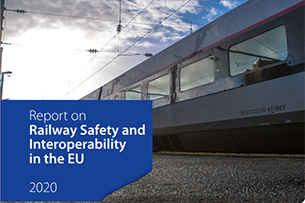
ERA publishes biennial Report on Progress with Railway Safety and Interoperability in the EU
The European Union Agency for Railways has published its latest biennial Report on Railway Safety and Interoperability in the European Union
Monitoring safety and interoperability of the Union railway system is one of the key tasks of the European Union Agency for Railways. The report published today is based on data for the reporting period 2018, and where available, for 2019. This report provides a thorough overview of the development of railway safety and interoperability in the European Union. It should facilitate evidence-based policy-making at EU level.
European railways remain among the safest in the world with one passenger fatality occurring each 25 billion kilometers on average. Major accidents with more than five fatalities are becoming increasingly rare, 2018 being the first year since the late 1980s with no major railway accident reported. ERA’s Executive Director, Josef Doppelbauer however urges the sector: ”We can never afford to be complacent. Unlike the European aviation and maritime industries, railways still have not implemented a systematic and comprehensive EU-wide safety occurrence reporting scheme, which would enable not only to learn effectively from major accidents, but also from incidents without victims. Several areas in which safety has been stagnating recently, such as level crossing and railway workers safety, or rolling stock fires, would particularly benefit from wider information sharing. I invite all railway parties to be strongly committed to enhancing railway safety by rigorously applying a robust Safety Management System and by implementing a positive railway safety culture.”
We notice a sound progress in railway interoperability concerning the alignment of operational frameworks in terms of rules, however only modest improvements are visible in making the railway assets interoperable. At border crossings the weaknesses in railway interoperability are most visible. In many areas, delays in the implementation of legal requirements in a few Member States consequently delay the interoperable deployment of railways in other countries, depriving them of the full benefits from the harmonised system. “We all need to enhance our efforts in particular in the area of railway data interoperability”, says Josef Doppelbauer: “high quality interoperable railway data are essential for European railways. I invite all parties involved to intensify their collaboration with the Agency.”
The report geographically covers the 28 Member States as of end 2019. Since Cyprus and Malta do not have railway systems that are covered by the EU legislation, the Union railway system is constituted by 26 Member States.
For any questions, you can use the contact us form on our website.
Press release Railway Safety and Interoperability report
English (202.43 KB - PDF)